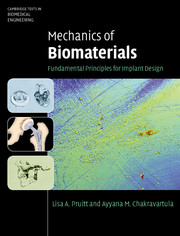Book contents
Prologue
Published online by Cambridge University Press: 05 June 2012
Summary
Mechanics of Biomaterials: Fundamental Principles for Implant Design provides the requisite engineering principles needed for the design of load-bearing medical implants with the intention of successfully employing synthetic materials to restore structural function in biological systems. This textbook makes available a collection of relevant case studies in the areas of orthopedics, cardiology, dentistry, and soft tissue reconstruction and elucidates the functional requirements of medical implants in the context of the specific restorative nature of the device. Each chapter opens with an exploratory question related to the chapter content in order to facilitate inquiry-based learning. Subsequently, a general overview, learning objectives, worked examples, clinical case studies, and problems for consideration are provided for each topic.
The organization of the book is designed to be self-contained, such that a student can be trained to competently engineer and design with biomaterials using the book as a standalone text, while practicing engineers or clinicians working with medical devices may use its content frequently in their careers as a guide and reference. The book comprises three basic sections: (i) overview of the materials science of biological materials and their engineered replacements; (ii) mechanical behavior of materials and structural properties requisite for implants; and (iii) clinical aspects of medical device design.
The first section of this book begins with a synopsis of medical devices and the fundamental issues pertaining to biocompatibility, sterilization, and design of medical implants. Engineered biomaterials including metals, ceramics, polymers, and composites are examined. The first segment of the book concludeswith a description of structural tissues. In these chapters, the mechanical properties of common synthetic and natural materials are discussed within the context of their structure-property relationships.
- Type
- Chapter
- Information
- Mechanics of BiomaterialsFundamental Principles for Implant Design, pp. xiv - xviPublisher: Cambridge University PressPrint publication year: 2011



